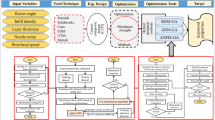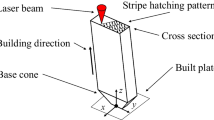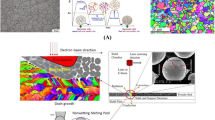Abstract
Characterization of various industrial components without impairing their future utility increases the necessity of nondestructive testing (NDT) techniques. In recent years, active thermography catches the researcher’s interest due to its distinct abilities like whole-field, contact-free, economic, defended, noninvasive, and nondestructive type of investigation. High energy deposition at low frequencies accompanied with enhanced depth resolution requirements of active thermography grabs the interest of quadratic frequency-modulated (QFM) stimulus in the recent past. On the other hand, enhanced defect detection is dependent on the extraction of an appropriate time-frequency component of chirped thermal response through a suitable processing technique. The present work employs velocity synchronous linear chirplet transformation (VSLCT) to precisely map the nonlinear chirp rate of the extracted quadratic frequency modulated thermal response. The proposed methodology is validated by carrying experimentation over carbon fiber and glass fiber reinforced polymer samples with artificially made flat bottom holes and Teflon inserts. Defect detectability of the proposed technique is quantified by comparing conventional techniques with the figure of merit (FoM) as signal to noise ratio (SNR), full width at half maxima (FWHM), and probability of detection (POD). An arduous manual inspection of processed data recommends automatic defect detection through segmentation without manual intervention. An active contour-based segmentation is performed post to VSLCT technique to facilitate the automatic visualization of defects.













Similar content being viewed by others
REFERENCES
Maldague, X.P., Theory and Practice of Infrared Technology for Nondestructive Testing, New York: Wiley, 2001.
Vavilov, V.P., Thermal nondestructive testing of materials and products: A review, Russ. J. Nondestr. Test., 2017, vol. 53, no. 10, pp. 707–730.
Tang Qingju et al., A new signal processing algorithm of pulsed infrared thermography, Infrared Phys. Technol., 2014, vol. 68, pp. 173–178.
Trétout, H., David, D., Marin, J.Y., Dessendre, M., Couet, M., and Avenas-Payan, I., An evaluation of artificial neural networks applied to infrared thermography inspection of composite aerospace structures, Review of Progress in Quantitative Nondestructive Evaluation, New York: Plenum Press, 1995, vol. 14, pp. 827–834.
Song Hominetal., Automated detection and quantification of hidden voids in triplex bonding layers using active lock-in thermography, NDT & E Int., 2015, vol. 74, pp. 94–105.
Wallbrink, C., Wade, S.A., and Jones, R., The effect of size on the quantitative estimation of defect depth in steel structures using lock-in thermography, J. Appl. Phys., 2007, vol. 101, no. 10, pp. 104907(1-8).
Castanedo, C.I. and Maldague, X.P., Pulsed phase thermography reviewed, Quant. Infrared Thermogr. J., 2004, vol. 1, no. 1, pp. 47-70.
Mulaveesala, R. and Tuli, S., Theory of frequency modulated thermal wave imaging for non-destructive subsurface defect detection, Appl. Phys. Lett., 2006, vol. 89, no. 19, pp. 191913(1-3).
Vijaya Lakshmi, A., Gopitilak, V., Muzammil M. Parvez, Subhani, S.K., and Ghali, V.S., Artificial neural networks based quantitative evaluation of subsurface anomalies in quadratic frequency modulated thermal wave imaging, Infrared Phys. Technol., 2019, vol. 97, pp. 108–115.
Pasha, M.M., Suresh, B., Babu, K.R., Subhani, Sk., and Subbarao, G.V., Barker coded modulated thermal wave imaging for defect detection of glass fiber reinforced plastic, ARPN J. Eng. Appl. Sci., 2018, vol. 13, no. 10, pp. 3475–3480.
Suresh, B., Subhani, S.K., Vijaya Lakshmi, A., Vardhan, V.H., and Ghali, V.S., Chirp Z transform based enhanced frequency resolution for depth resolvable non stationary thermal wave imaging, Rev. Sci. Instr., 2017, vol. 88, no. 1, article ID 014901.
Subhani, Sk., Suresh, B., and Ghali, V.S., Quantitative subsurface analysis using frequency modulated thermal wave imaging, Infrared Phys. Technol., 2018, vol. 88, pp. 41–47.
Subhani, Sk. and Ghali, V.S., Measurement of thermal diffusivity of fibre reinforced polymer using quadratic frequency modulated thermal wave imaging, Infrared Phys. Technol., 2019, vol. 99, pp. 187–192.
Subhani, Sk., Chandra Sekhar Yadav, G.V.P., and Ghali, V.S., Defect Characterisation Using Pulse Compression-Based Quadratic Frequency Modulated Thermal Wave Imaging, IET Sci. Meas. Technol., 2020, vol. 14, no. 2, pp. 165–172.
Tabatabaei, N., Matched-Filter Thermography, Appl. Sci., 2018, vol. 8, no. 4, pp. 581–599.
Sharma, A., Mulaveesala, R., and Arora, V., Novel Analytical Approach for Estimation of Thermal Diffusivity and Effusivity for Detection of Osteoporosis, IEEE Sens. J., 2020, vol.20, no. 11, pp. 6046–6054.
Pasha, M.M., Subbarao, G.V., Suresh, B., Tabassum, S., Inspection of defects in CFRP based on principal components, Int. J. Recent Technol. Eng., 2019, vol. 8, no. 3, pp. 2367–2370.
Subhani, S.K., Suresh, B., and Ghali, V.S., Empirical mode decomposition approach for defect detection in non-stationary thermal wave imaging, NDT & E Int., 2016, vol. 81, pp. 39–45.
Subhani, S.K., Suresh, B., and Ghali, V.S., Orthonormal Projection Approach for Depth-Resolvable Subsurface Analysis in Non-Stationary Thermal Wave Imaging, Insight – Nondestr. Test. Cond. Monit., 2016, vol. 58, no. 1, pp. 42–45.
Allen, J., Short term spectral analysis, synthesis, and modification by discrete Fourier transform, IEEE Trans. Acoust. Speech Signal Process., 1977, vol. 25, no. 3, pp. 235–238.
Rajagopalan, S. et al., Analytic-wavelet-ridge-based detection of dynamic eccentricity in brushless direct current (BLDC) motors functioning under dynamic operating conditions, IEEE Trans. Ind. Electron., 2007, vol. 54, no. 3, pp. 1410–1419.
Mann, S. and Haykin, S., The chirplet transform: Physical considerations, IEEE Trans. Signal Process., 1995, vol. 43, no. 11, pp. 2745–2761.
Yang, Y., Zhang, W., Peng, Z., and Meng, G., Multi component signal analysis based on polynomial chirplet transform, IEEE Trans. Ind. Electron., 2013, vol. 60, no. 9, pp. 3948–3956.
Suresh, B., Subhani, S.K., Ghali, V.S., and Mulaveesala, R., Subsurface details fusion for anomaly detection in non-stationary thermal wave imaging, Insight, 2017, vol. 59, no. 10.
Ravipati, J.L., Vijaya Lakshmi, A., Subbarao, G.V., Multi resolution based enhanced subsurface analysis in thermal wave detection and ranging, J. Adv. Res. Dyn. Control Syst., 2017, vol. 9.
Tuli, S. and Mulaveesala, R., Defect detection by pulse compression in frequency modulated thermal wave imaging, QIRT, 2005, vol. 2, pp. 41–54.
D. Gabor, Theory of communication. Part I: The analysis of information, J. Instrum. Electr. Eng., Part 3, 1947, vol. 94, no. 73, p. 58.
Yunpeng Guan, Ming Liang, and Dan-Sorin Necsulescu, Velocity synchronous linear chirplet transform, IEEE Trans. Ind. Electron., 2018, vol. 66, no. 8, pp. 6270–6280.
Gampa, V.P., Chandra Sekhar Yadav, Ghali Venkata Subbarao, Sonali Reddy, B., Omprakash, B., and Chaithanya Reddy, Ch., Green’s function based analytical model for enhanced defect detection using depth resolvable non-stationary thermal wave imaging, J. Green Eng., 2020, vol. 10, no. 12, pp. 12933–12947.
Vijaya Lakshmi, A., Ghali, V.S., Gampa V.P. Chandra Sekhar Yadav, and Gopi Tilak, V., A machine learning based approach for defect detection and characterization in non-linear frequency modulated thermal wave imaging, Int. J. Emerging Technol. Eng. Res., 2019, vol. 7, no. 11.
Duan, Y., et al., Reliability assessment of pulsed thermography and ultrasonic testing for impact damage of CFRP panels, NDT & E Int., 2018, vol. 102, pp. 77–83.
Vavilov, V.P. and Pawar, S.S, Determining the lateral size of subsurface defects during active thermal nondestructive testing, Russ. J. Nondestr. Test., 2016, vol. 52, no. 9, pp. 528–531.
Chan, T. and Vese, L., Active contours without edges, IEEE Trans. Image Process., 2001, vol. 10, no. 2, pp. 266–277.
Suresh, B., Jammula, S.K., Subbarao, G.V., Automatic detection of subsurface anomalies using non-linear chirped thermography, Int. J. Innovative Technol. Explor. Eng., 2019, vol. 8, no. 6, pp. 1247–1249.
Shawn Lankton and Allen Tannenbaum, Localizing Region-Based Active Contours, IEEE Trans. Image Process., 2008, vol. 17, no. 11, pp. 2029–2039.
Funding
Naval Research Board partially supported this work, India grant no. NRB-423/MAT/18-19 and FIST sponsored ECE Department under grant no. SR/FST/ETII/2019/450.
Author information
Authors and Affiliations
Corresponding author
Rights and permissions
About this article
Cite this article
Chandra Sekhar Yadav, G.V., Ghali, V.S. & Baloji, N.R. A Time Frequency-Based Approach for Defect Detection in Composites Using Nonstationary Thermal Wave Imaging. Russ J Nondestruct Test 57, 486–499 (2021). https://doi.org/10.1134/S1061830921060061
Received:
Revised:
Accepted:
Published:
Issue Date:
DOI: https://doi.org/10.1134/S1061830921060061




